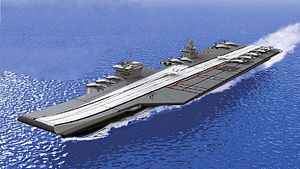The Indian Navy’s latest aircraft carrier, the 65,000-ton supercarrier INS Vishal, the second ship of the Vikrant-class, will be powered by a nuclear reactor, according to anonymous Indian Navy sources. Furthermore, the INS Vishal will be able to accommodate up to 55 aircraft (35 fixed-wing combat aircraft and 20 rotary wing aircraft), launched using a catapult assisted take-off but arrested recovery (CATOBAR) aircraft launch system, incorporating U.S. defense contractor’s General Atomics’ new electromagnetic aircraft launch system (EMALS) technology, the Business Standard reports on November 7.
Given the incorporation of these new technologies, the Indian Navy source also revealed that the aircraft carrier will not enter service until the 2030s. (Originally, India planned to induct the carrier in the 2020s.) It is still unclear when the construction of the new warship will begin.
The INS Vishal will be the first non-Western aircraft carrier equipped with the complex CATOBAR launch capability. CATOBAR aircraft launch systems put less strain on the airframe of planes during takeoff reducing maintenance cost in the long run and also allows carrier-based aircraft to carry a heavier weapons payload. Furthermore, CATOBAR launch systems increase the sortie rates of carrier air wings by allowing a faster landing and takeoff rate.
The Indian Navy’s preference for the CATOBAR aircraft launch system indicates that the new warship will in all likelihood not carry MiG-29K Fulcrum fighter jets, the current mainstay of India’s naval combat aviation. This will open up opportunities for competitors, in particular France and the United States, to push their naval combat aircraft. As I reported previously (See: “India to Consider French Fighter Jets For Navy’s Newest Aircraft Carrier”), representatives of French aircraft maker Dassault Aviation pitched the naval version of the Dassault Rafale twin-engine, fourth generation multirole fighter to the Indian Navy in early 2016. (The United States has been quietly pushing Lockheed Martin’s F-35c Lightning II and McDonnell Douglas F/A 18 Hornets).
The domestically designed and produced Tejas Light Combat Aircraft (LCA), next to being deployed aboard the INS Vikrant, India’s first indigenously built aircraft carrier, is also slated to serve on the INS Vishal, according to Indian Navy officials. Two naval prototypes of the Tejas LCA successfully conducted test flights from a so-called Shore Based Test Facility—a full-scale model of an aircraft carrier deck—in Goa earlier in the year. Nevertheless, senior Indian defense officials have repeatedly stated that the Indian Navy’s naval combat aviation requirements cannot be covered by domestic production.
Selecting the right aircraft will be critical for India’s naval power.
“The type of aircraft stationed aboard the new supercarrier will heavily influence the new vessel’s design and is thus of critical importance,” as I explained elsewhere. In the middle of 2015, Russia, France, the United Kingdom, and the United States received requests for “technical and costing proposals” by the Indian Navy’s Naval Design Bureau regarding the design of its new aircraft carrier (See: “Will India Buy Russia’s New Supercarrier?”). Should the adaptation of the CATOBAR system be officially confirmed, it will almost certainly rule out Russian participation in the construction of the carrier given strict U.S. export control and intellectual property restrictions.
India has no experience with nuclear propulsion in a surface combat vessel, so U.S.-India or France-India technical cooperation on nuclear technology is a possibility. However, among other things, this would require changes to current U.S. nuclear policy. India and the United States have formed a Joint Working Group on Aircraft Carrier Technology Cooperation (JWGACTC) as part of the so-called bilateral Defense Trade and Technology Initiative (DTTI). According to publicly available information, the talks were largely confined to the the possibility of incorporating EMALS technology on the INS Vishal and did not discuss nuclear propulsion.

































